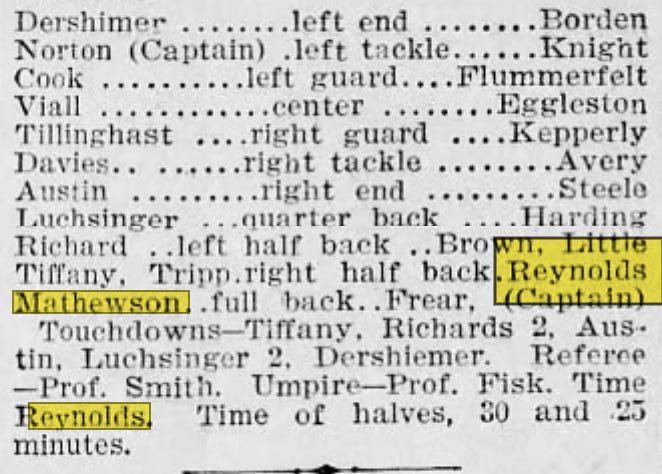Marshall Reynolds: From Tunkhannock to Penn, an All-American
Reynolds briefly served as captain for undefeated 1905 Quakers.
Tunkhannock’s most famous turn-of-the-20th-century athlete was Walter Tewksbury, a two-time gold medalist at the Olympics; the kind of accolade that will occasionally be referenced and forever be celebrated and printed in record books.
More than 125 years past his prime and 50-plus years past his death, Tewksbury is still remembered in Tunkhannock. Tewksbury’s local historical marker tells not only of his athletic achievements, but that he served generations of Tunkhannockians as a dentist.
Another native son, who, during the same era, achieved immortality on the football field was Marshall Reynolds. However, unlike Tewksbury, Reynolds lived most of his adult life in Wyoming — the state — which explains why his greatness, at least locally, has faded with time.
Reynolds was born July 9, 1881, in West Nicholson Township, Wyoming County. His family soon moved to nearby Tunkhannock and Reynolds played football for the Tunkhannock High School team. The Keystone Academy football team began its 1897 season with a 34-0 win against Tunkhannock. Reynolds was Tunkhannock’s starting right halfback. Future Hall of Fame baseball pitcher Christy Mathewson was Keystone’s starting fullback.
After graduating from Tunkhannock, Reynolds matriculated to Mansfield Normal School and then the University of Pennsylvania. While studying law at Penn, Reynolds played football.
Walter Camp selected Reynolds as an All-American in 1904, when national champion Penn went 12-0 and allowed only four points all season. Reynolds, who also punted, was Camp’s choice as the second-team left halfback.
Immediately following the season, Reynolds was voted by teammates as captain for the 1905 season.
“The Quakers’ new captain has played three years on the varsity,” reports said. “He graduates from the law department next spring, but expects to return for a postgraduate course. Reynolds comes from Tunkhannock, Penn. He prepared at the Mansfield Normal School. He made the Quaker team in his freshman year, his remarkable kicking ability insuring him a place, although he was light in weight.
“He is 23 years old and is about 6-feet, 165 pounds. He played on the 1901 Pennsylvania team and also was on the baseball team the following spring. The fall of 1902, he found his University work would not permit him to engage in football. He played in 1903 and 1904 at left halfback, the same position he played in 1901.”
Unfortunately, Reynolds’ status as captain was short-lived.
Early in the 1905 season, Penn officials declared Reynolds ineligible to play. This saga played out over several months and was covered extensively by the Philadelphia press.
“The reason was the stand taken by the Law School dean, who declared that the department did not have such a course as Reynolds desired to take,” one report said. “The impression, however, is that Reynolds has been sacrificed in accordance with Pennsylvania’s strict eligibility code.”
It’s worth noting that Reynolds couldn’t leave the game alone and served as head linesman during the 1905 game between rivals Lehigh and Lafayette. Penn went on to a 12-0-1 record — the tie coming against Lafayette, coached by Wilkes-Barre’s Al Bull.
Post-Penn, Reynolds briefly lived in Tunkhannock before ultimately settling in Wyoming.
Reynolds, 90, died in 1971 and his obituary was picked up by the national wire. His obituary stated he was “one of Wyoming’s oldest practicing lawyers” who served in the Wyoming House of Representatives and was also appointed U.S. Commissioner in 1942.
Reynolds served in World War I, according to the obituary, and also briefly served in the Spanish-American War and tried to enlist for WWII but was denied because of his age.
Greater Scranton/Wilkes-Barre area All-American roll call
1894: Charles Gelbert, University of Pennsylvania (Hawley native, Scranton public schools)
1895: Alfred E. Bull, University of Pennsylvania (Wilkes-Barre native, Wyoming Seminary); Charles Gelbert, University of Pennsylvania (Hawley native, Scranton public schools)
1896: Charles Gelbert, University of Pennsylvania (Hawley native, Scranton public schools)
1903: Frank Piekarski, University of Pennsylvania (Nanticoke native, Wyoming Seminary)
1904: Tom Butkiewicz, University of Pennsylvania (Nanticoke native); James Cooney, University of Pennsylvania (Scranton native, School of Lackawanna); Frank Piekarski, University of Pennsylvania (Nanticoke native, Wyoming Seminary); Marshall Reynolds, University of Pennsylvania (Tunkhannock native)
1906: James Cooney, University of Pennsylvania (Scranton native, School of Lackawanna)





